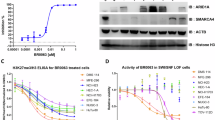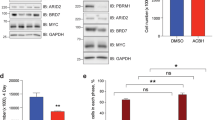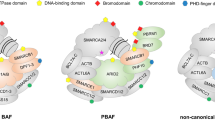Abstract
Tumor suppressor genes and oncogenes are both commonly altered during carcinogenesis. For oncogenes and other genes that drive growth, targeting mutated or activated forms (such as the EGFR-Her2/Nneu pathway) has been shown to be an effective anti-cancer approach. Pharmacologically targeting tumor suppressor genes has not been as fruitful, as many tumor suppressor genes are irreversibly silenced through somatic mutation or entirely deleted during carcinogenesis, thereby making it difficult to restore gene function. BRM, a key SWI/SNF complex subunit and a putative tumor suppressor gene, is inactivated in 15–20% of many solid tumor types. Unlike other tumor suppressor genes, the loss of BRM has been shown to be a reversible epigenetic change, rather than an irreversible genetic alteration. Using a high throughput drug screen, we identified a number of compounds that could effectively restore BRM expression and function. Two of these compounds, RH (RH02032) and GK (GK0037), were found to be such reactivating agents. Both compounds led to robust re-expression of BRM, induced downstream expression of BRM-dependent genes and inhibited BRM-dependent growth across a wide range of BRM-deficient cancer cell lines of different origins. We therefore show, for the first time, that pharmacologic reversal of epigenetic changes of the SWI/SNF chromatic remodeling complex subunit, BRM, is a potentially viable and novel therapeutic approach.
This is a preview of subscription content, access via your institution
Access options
Subscribe to this journal
Receive 50 print issues and online access
$259.00 per year
only $5.18 per issue
Buy this article
- Purchase on SpringerLink
- Instant access to full article PDF
Prices may be subject to local taxes which are calculated during checkout



Similar content being viewed by others
References
Betz BL, Strobeck MW, Reisman DN, Knudsen ES, Weissman BE . (2002). Re-expression of hSNF5/INI1/BAF47 in pediatric tumor cells leads to G1 arrest associated with induction of p16ink4a and activation of RB. Oncogene 21: 5193–5203.
Bourachot B, Yaniv M, Muchardt C . (2003). Growth inhibition by the mammalian SWI-SNF subunit Brm is regulated by acetylation. EMBO J 22: 6505–6515.
Carlson M, Laurent BC . (1994). The SNF/SWI family of global transcriptional activators. Curr Opin Cell Biol 6: 396–402.
DeCristofaro MF, Betz BL, Rorie CJ, Reisman DN, Wang W, Weissman BE . (2001). Characterization of SWI/SNF protein expression in human breast cancer cell lines and other malignancies. J Cell Physiol 186: 136–145.
Dunaief JL, Strober BE, Guha S, Khavari PA, Alin K, Luban J et al. (1994). The retinoblastoma protein and BRG1 form a complex and cooperate to induce cell cycle arrest. Cell 79: 119–130.
Glaros S, Cirrincione GM, Muchardt C, Kleer CG, Michael CW, Reisman D . (2007). The reversible epigenetic silencing of BRM: implications for clinical targeted therapy. Oncogene 26: 7058–7066.
Gramling S, Reisman D . (2011). Discovery of BRM targeted therapies: novel reactivation of an anticancer gene. Lett Drug Des Discov 8: 93–99.
Hendricks KB, Shanahan F, Lees E . (2004). Role for BRG1 in cell cycle control and tumor suppression. Mol Cell Biol 24: 362–376.
Klochendler-Yeivin A, Muchardt C, Yaniv M . (2002). SWI/SNF chromatin remodeling and cancer. Curr Opin Genet Dev 12: 73–79.
Liu R, Liu H, Chen X, Kirby M, Brown PO, Zhao K . (2001). Regulation of CSF1 promoter by the SWI/SNF-like BAF complex. Cell 106: 309–318.
Medina PP, Romero OA, Kohno T, Montuenga LM, Pio R, Yokota J et al. (2008). Frequent BRG1/SMARCA4-inactivating mutations in human lung cancer cell lines. Hum Mutat 29: 617–622.
Mizutani T, Ito T, Nishina M, Yamamichi N, Watanabe A, Iba H . (2002). Maintenance of integrated proviral gene expression requires Brm, a catalytic subunit of SWI/SNF complex. J Biol Chem 277: 15859–15864.
Morrison AJ, Shen X . (2006). Chromatin modifications in DNA repair. Results Probl Cell Differ 41: 109–125.
Muchardt C, Bourachot B, Reyes JC, Yaniv M . (1998). ras transformation is associated with decreased expression of the brm/SNF2alpha ATPase from the mammalian SWI-SNF complex. EMBO J 17: 223–231.
Peterson CL, Workman JL . (2000). Promoter targeting and chromatin remodeling by the SWI/SNF complex. Curr Opin Genet Dev 10: 187–192.
Reisman D, Glaros S, Thompson EA . (2009). The SWI/SNF complex and cancer. Oncogene 28: 1653–1668.
Reisman DN, Strobeck MW, Betz BL, Sciariotta J, Funkhouser Jr W, Murchardt C et al. (2002). Concomitant down-regulation of BRM and BRG1 in human tumor cell lines: differential effects on RB-mediated growth arrest vs CD44 expression. Oncogene 21: 1196–1207.
Reisman DN, Sciarrotta J, Bouldin TW, Weissman BE, Funkhouser WK . (2005). The expression of the SWI/SNF ATPase subunits BRG1 and BRM in normal human tissues. Appl Immunohistochem Mol Morphol 13: 66–74.
Reisman DN, Sciarrotta J, Wang W, Funkhouser WK, Weissman BE . (2003). Loss of BRG1/BRM in human lung cancer cell lines and primary lung cancers: correlation with poor prognosis. Cancer Res 63: 560–566.
Roberts CW, Leroux MM, Fleming MD, Orkin SH . (2002). Highly penetrant, rapid tumorigenesis through conditional inversion of the tumor suppressor gene Snf5. Cancer Cell 2: 415–425.
Sansam CG, Roberts CW . (2006). Epigenetics and cancer: altered chromatin remodeling via Snf5 loss leads to aberrant cell cycle regulation. Cell Cycle 5: 621–624.
Shen H, Powers N, Saini N, Comstock CE, Sharma A, Weaver K et al. (2008). The SWI/SNF ATPase Brm is a gatekeeper of proliferative control in prostate cancer. Cancer Res 68: 10154–10162.
Simone C . (2006). SWI/SNF: the crossroads where extracellular signaling pathways meet chromatin. J Cell Physiol 207: 309–314.
Strobeck MW, Reisman DN, Gunawardena RW, Betz BL, Angus SP, Knudsen KE et al. (2002). Compensation of BRG-1 function by Brm: insight into the role of the core SWI-SNF subunits in retinoblastoma tumor suppressor signaling. J Biol Chem 277: 4782–4789.
Strober BE, Dunaief JL, Guha, Goff SP . (1996). Functional interactions between the hBRM/hBRG1 transcriptional activators and the pRB family of proteins1. Mol Cell Biol 16: 1576–1583.
Wang W, Cote J, Xue Y, Zhou S, Khavari PA, Biggar SR et al. (1996a). Purification and biochemical heterogeneity of the mammalian SWI-SNF complex. EMBO J 15: 5370–5382.
Wang W, Xue Y, Zhou S, Kuo A, Cairns BR, Crabtree GR . (1996b). Diversity and specialization of mammalian SWI/SNF complexes. Genes Dev 10: 2117–2130.
Wong AK, Shanahan F, Chen Y, Lian L, Ha P, Hendricks K et al. (2000). BRG1, a component of the SWI-SNF complex, is mutated in multiple human tumor cell lines. Cancer Res 60: 6171–6177.
Yamamichi N, Inada K, Ichinose M, Yamamichi-Nishina M, Mizutani T, Watanabe H et al. (2007). Frequent loss of Brm expression in gastric cancer correlates with histologic features and differentiation state. Cancer Res 67: 10727–10735.
Yamamichi N, Yamamichi-Nishina M, Mizutani T, Watanabe H, Minoguchi S, Kobayashi N et al. (2005). The Brm gene suppressed at the post-transcriptional level in various human cell lines is inducible by transient HDAC inhibitor treatment, which exhibits antioncogenic potential. Oncogene 24: 5471–5481.
Acknowledgements
GL is funded by the Alan B Brown Chair in Molecular Genomics, CCO Chair in Experimental Therapeutics and Population Studies, and the Posluns Family Foundation; Reisman lab funding for this paper is from NCI: R03CA128038–02 and 1R01CA136683–01A1.
Author information
Authors and Affiliations
Corresponding author
Ethics declarations
Competing interests
The authors declare no conflict of interest.
Additional information
Supplementary Information accompanies the paper on the Oncogene website
Supplementary information
Rights and permissions
About this article
Cite this article
Gramling, S., Rogers, C., Liu, G. et al. Pharmacologic reversal of epigenetic silencing of the anticancer protein BRM: a novel targeted treatment strategy. Oncogene 30, 3289–3294 (2011). https://doi.org/10.1038/onc.2011.80
Received:
Revised:
Accepted:
Published:
Issue date:
DOI: https://doi.org/10.1038/onc.2011.80
Keywords
This article is cited by
-
SMARCA4-deficient thoracic sarcoma: a distinctive clinicopathological entity with undifferentiated rhabdoid morphology and aggressive behavior
Modern Pathology (2017)
-
Epigenomic regulation of oncogenesis by chromatin remodeling
Oncogene (2016)
-
Concomitant loss of SMARCA2 and SMARCA4 expression in small cell carcinoma of the ovary, hypercalcemic type
Modern Pathology (2016)
-
Identifying targets for the restoration and reactivation of BRM
Oncogene (2014)
-
RETRACTED ARTICLE: Oncogenic targeting of BRM drives malignancy through C/EBPβ-dependent induction of α5 integrin
Oncogene (2014)



